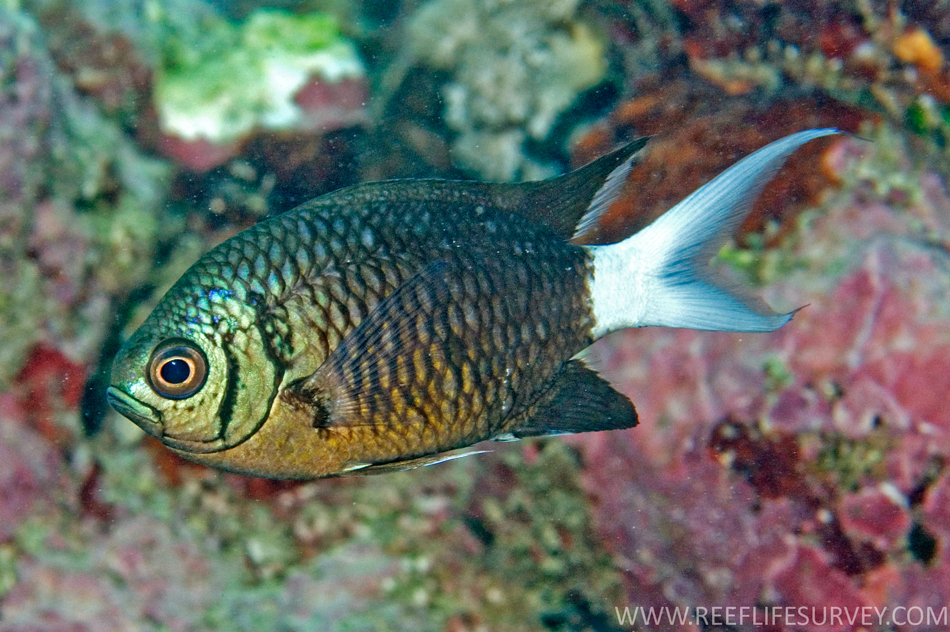Pale-tail Puller, Chromis xanthura (Bleeker 1854)
Other Names: Long-tail Puller, Paletail Chromis, Pale-tail Chromis

A Pale-tail Puller, Chromis xanthura, on the Great Barrier Reef off Cairns, Queensland. Source: Andrew J. Green / Reef Life Survey. License: CC by Attribution
Summary:
A bluish-grey chromis with dark scale edges, usually a white tail, and a blackish bar at the preoperculum and another at the rear of the head. Juveniles have yellow on the outer caudal-fin lobes and yellow on the prolonged soft dorsal and anal fin rays. Some individuals have a black caudal fin.
Cite this page as:
Bray, D.J. 2022, Chromis xanthura in Fishes of Australia, accessed 25 Apr 2024, https://fishesofaustralia.net.au/home/species/331
Pale-tail Puller, Chromis xanthura (Bleeker 1854)
More Info
|
Distribution |
Offshore reefs of north Western Australia, Ashmore Reef in the Timor Sea, and the far northern Great Barrier Reef and reefs in the Coral Sea, to the Capricorn-Bunker Group in the south, Queensland; also Cocos (Keeling) Islands and Christmas Island in the eastern Indian Ocean, and the Lord Howe Province in the Tasman Sea. Elsewhere the species occurs in the tropical, Indo-west-central Pacific. |
|
Features |
Dorsal fin XIII, 10-11; Anal fin II, 9-10; Pectoral fin 18-20; Lateral line scales 16-19; Gill rakers (first arch) 26-30. Body depth 2.1-2.3 in SL. |
|
Similar Species |
The similar Doublebar Chromis, Chromis opercularis differs in having a well-defined broad dark bar on the rear of the gill cover that extends onto the pectoral-fin base (vs. a narrower and less-defined blackish bar). Adult C. opercularis also have a dusky-grey to brownish tail, often with a yellowish caudal peduncle, while adult C. xanthura usually have a white tail and caudal peduncle (occasionally a dark tail). Both species occur at Cocos (Keeling) Islands and Christmas Island in the eastern Indian Ocean. Juveniles of both species are very similar and difficult to tell apart. |
|
Etymology |
The specific name xanthura is from the Greek xanthos (= yellow) and oura (= tail) in reference to the yellow colour on the caudal-fin lobes of juveniles. |
|
Species Citation |
Heliases xanthurus Bleeker 1854, Natuurkundig Tijdschrift voor Nederlandsch Indië 6: 107. Type locality: Banda Neira, Banda Islands, Molucca Islands, Indonesia. |
|
Author |
Bray, D.J. 2022 |
|
Resources |
Pale-tail Puller, Chromis xanthura (Bleeker 1854)
References
Allen, G.R. 1975. Damselfishes of the South Seas. New Jersey : T.F.H. Publications 237 pp.
Allen, G.R. 1991. Damselfishes of the World. Melle, Germany : Mergus Verlag 271 pp.
Allen, G.R. 1993. Fishes of Ashmore Reef and Cartier Island. Records of the Western Australian Museum, Supplement 44: 67-91
Allen, G.R. 1997. Marine Fishes of Tropical Australia and South-east Asia. Perth : Western Australian Museum 292 pp. 106 pls.
Allen, G. R. 2001. Family Pomacentridae. pp. in Carpenter, K.E. & Niem, T.H. (eds). The Living Marine Resources of the Western Central Pacific. FAO Species Identification Guide for Fisheries Purposes. Rome : FAO Vol. 6 pp. 3381-4218.
Allen, G.R. 2018. Chromis torquata, a new species of damselfish (Pomacentridae) from Mauritius and Réunion. aqua, International Journal of Ichthyology 24(1): 15-22. See ref online
Allen, G.R. & Erdmann, M.V. 2012. Reef fishes of the East Indies. Perth : Tropical Reef Research 3 vols, 1260 pp.
Allen, G.R. & Smith-Vaniz, W.F. 1994. Fishes of Cocos (Keeling) Islands. Atoll Research Bulletin 412: 1-21
Allen, G.R. & Steene, R.C. 1988. Fishes of Christmas Island Indian Ocean. Christmas Island : Christmas Island Natural History Association 197 pp.
Allen, G.R., Steene, R.C. & Orchard, M. 2007. Fishes of Christmas Island. Christmas Island : Christmas Island Natural History Association 2 edn, 284 pp.
Bleeker, P. 1854. Derde bijdrage tot de kennis der ichthyologische fauna van de Banda-eilanden (1). Natuurwetenschappelijk Tijdschrift voor Nederlandsch Indië 6: 89-114. See ref at BHL
Bleeker, P. 1877. Mémoire sur les Chromides marins ou Pomacentroïdes de l'Inde archipélagique. Natuurkundige Verhandelingen van de Bataafsche Hollandsche Maatschappye der Wetenschappen te Haarlem 3 2(6): 1-166
Choat, J.H., van Herwerden, L., Robbins, W.D., Hobbs, J.P. & Ayling, A.M. 2006. A report on the ecological surveys undertaken at Middleton and Elizabeth Reefs, February 2006. Report by James Cook University to the Department of the Environment and Heritage. 65 pp.
Hobbs, J-P.A., Newman, S.J., Mitsopoulos, G.E.A., Travers, M.J., Skepper, C.L., Gilligan, J.J., Allen, G.R., Choat, H.J. & Ayling, A.M. 2014. Checklist and new records of Christmas Island fishes: the influence of isolation, biogeography and habitat availability on species abundance and community composition. Raffles Bulletin of Zoology Supplement 30: 184–202.
Hobbs, J-P.A., Newman, S .J., Mitsopoulos, G.E.A., Travers, M.J., Skepper, C.L., Gilligan, J.J., Allen, G.R., Choat, H.J. & Ayling, A.M. 2014. Fishes of the Cocos (Keeling) Islands: new records, community composition and biogeographic significance. Raffles Bulletin of Zoology Supplement 30: 203–219.
Hutchins, J.B. 2001. Biodiversity of shallow reef fish assemblages in Western Australia using a rapid censusing technique. Records of the Western Australian Museum 20: 247-270.
Kuiter, R.H. 1992. Tropical Reef-Fishes of the Western Pacific, Indonesia and Adjacent Waters. Jakarta : PT Gramedia Pustaka Utama 314 pp. pls.
Motomura, H., Nishiyama, H. & Chiba, S.N. 2017. Review of the Chromis xanthura species group (Perciformes: Pomacentridae), with description of a new species. Ichthyological Research 65: 177-191 https://doi.org/10.1007/s10228-017-0601-8
Randall, J.E. 2005. Reef and shore fishes of the South Pacific. New Caledonia to Tahiti and the Pitcairn Islands. Honolulu : University of Hawaii Press 707 pp.
Randall, J.E., Allen, G.R. & Steene, R. 1990. Fishes of the Great Barrier Reef and Coral Sea. Bathurst : Crawford House Press 507 pp. figs.
Randall, J.E., Allen, G.R. & Steene, R. 1997. Fishes of the Great Barrier Reef and Coral Sea. Bathurst : Crawford House Press 557 pp. figs.










